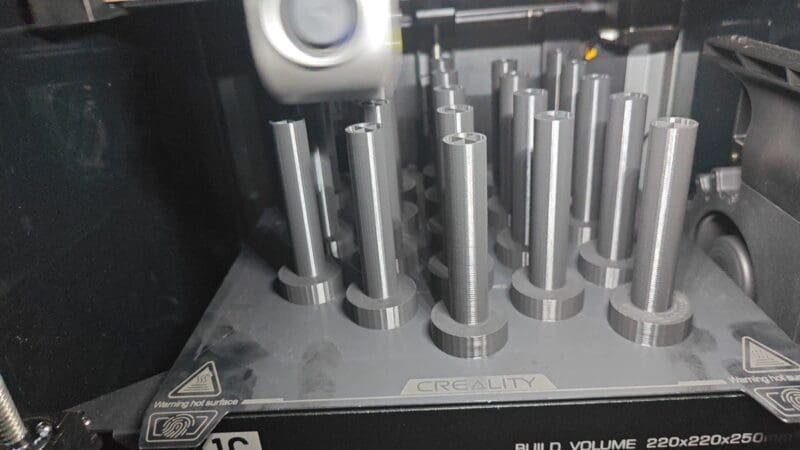Creality Sonic Pad Compatibility Chart (Feb 2024 Updates)
What is Sonic Pad?
The Creality Sonic Pad is a device that makes it easy to change the firmware on your 3D printer, using the Klipper solution. By running the firmware on an external board, the mainboard of your 3D printer no longer needs to do the heavy lifting of processing, which means it can be left to simply interpret the G-code. This allows you to run more complex processes like input shaping.
The Sonic Pad can run Klipper with Fluidd and Mainsail and has a built-in touchscreen running a reskinned version of KlipperScreen. It also has 4 USB ports that connect up to four 3D printers or a configuration with webcams.
How Does Sonic Pad Work?

The Sonic Pad comes with many profiles of Creality-made and third-party 3D printers. These profiles allow you to install the firmware onto an SD card via an adapter, and then flash that firmware to the 3D printer. Instructions are presented on the screen, making the installation process very easy.
However, it is important to note that some 3D printers have more than one chipset model. This makes it crucial to check the chipset on your 3D printer before you begin the installation process.
Overall, the Creality Sonic Pad would be an excellent addition to a maker’s collection if they would like to avoid the potential headache of compiling Klipper themselves and get right to printing. But what 3D printers does the Sonic Pad support?
In this article, we will look into what 3D printers the Sonic Pad is compatible with, as well as what can be done if your 3D printer doesn’t have an official profile.
Which Creality printers are covered with Sonic Pad?
To ensure that the firmware is compatible with your 3D printer, the Sonic Pad has pre-configured profiles as of the V1.0.6.46.25 Firmware Update for the following printers:
| Printer Series | Compatible Printers |
|---|---|
| Ender-2 Series | Ender-2 Pro |
| Ender-3 Series | Ender-3 V3 SE/ Ender-3 Pro/Ender-3 V2/Ender-3 V2 Neo/Ender-3 Max Neo/Ender-3 S1/Ender-3 S1 Pro/Ender-3 S1 Plus/Ender-3 Max |
| Ender-5/6/7 Serirs | Ender-5 Plus/Ender-5 S1/Ender-5 Pro/Ender-6/Ender-7 |
| CR-6 Series | CR-6 Max/CR-6 SE |
| CR-10 Series | CR-10 Smart/CR-10S Pro V2/CR-10 V3/CR-10 Smart Pro/CR-10/CR-10 S4/CR-10 S5 |
| CR-Series | CR-200B/CR-30/CR-M4/Sermoon D1 |
| Sermoon Series | Sermoon D1 |
| Other Brands Models | Pursa Mini/Flsun SR/Flsun Q5 |
The Sonic Pad is now compatible with the Ender-3 V3 SE. Once connected to the Sonic Pad, printing speeds can be increased by 2 to 5 times, enhancing work efficiency. Please be aware that a stable connection with the Ender-3 V3 SE requires the use of the Creality Sonic Pad Serial Cable.
Creality Sonic Pad Serial Cable: Shop Link
Create Your Own Profile
If your 3D printer is not on this list, there are still options available. The Klipper firmware is open-source, which means that anyone can create their own profile for their 3D printer and share it with the community.
If you have some technical know-how, you can create your own profile by following the instructions provided by the Klipper community.
To add a 3D printer that does not have a profile, the Creality Sonic Pad has a unique feature called User-Defined Printer Compilation. This allows users to enter a few details about their 3D printer and generate the corresponding firmware.
However, this feature leaves out a crucial component of the Klipper installation – creating the config file. Luckily, many pre-made config files can be found on the Klipper GitHub page, which can be used as guidance or found for unsupported printers.
However, this task can be confusing for beginners and may turn them away from using Klipper.

If you want to go the DIY route, Creality has posted a video on using the User-Defined Model Adaptation for the Prusa MK3S. While your printer’s specifications may differ, it can be a helpful starting point to get started.
Klipper is compatible with most hobbyist 3D printers that use ARM, AVR, and PRU-based micro-controllers, with the addition of a Raspberry Pi or a Sonic Pad.
The Sonic Pad supports many printers, particularly the Creality ecosystem, which makes the most sense when working with Creality printers. However, not all printers have a profile or are compatible with the Sonic Pad.
Adding a printer to the workspace shouldn’t be a significant difficulty, even if it isn’t included by default.
The Sonic Pad is an excellent addition for makers that want to avoid the headache of compiling Klipper themselves and start printing right away. The firmware can run on an external board, which allows the printer’s mainboard to interpret the G-code, making it easier to run complex processes like input shaping.
The Sonic Pad runs Klipper with Fluidd and Mainsail, and the built-in touchscreen runs a reskinned version of KlipperScreen, allowing easy access to different ports. The device also features four USB ports to connect up to four 3D printers or a setup with webcams.
The Sonic Pad comes with many profiles of Creality-made and third-party 3D printers that contain a klipper.cfg file with original equipment manufacturer (OEM) values. Installing the firmware onto an SD card via an adapter and flashing it to the 3D printer is straightforward, with on-screen instructions making the installation process easy.
However, some 3D printers have more than one chipset model, making it crucial to check the chipset on your 3D printer before beginning the installation process.
DISCLOSURE: THIS POST MAY CONTAIN AFFILIATE LINKS, MEANING I GET A COMMISSION IF you DECIDE TO MAKE A PURCHASE THROUGH MY LINKS, AT NO COST TO YOU. PLEASE READ MY DISCLOSURE FOR MORE INFO.



